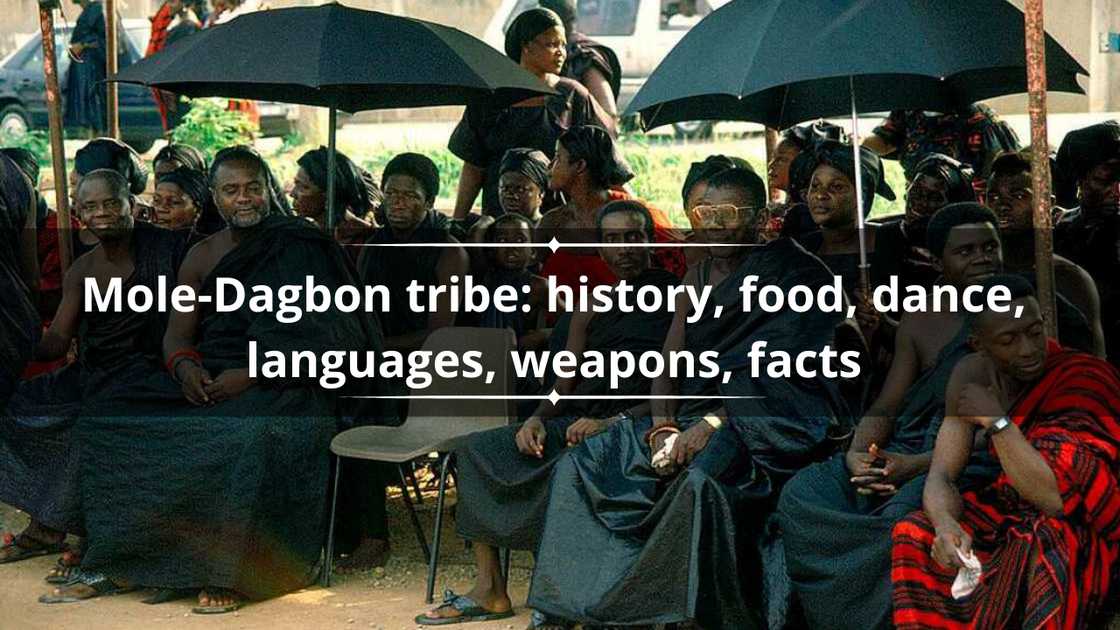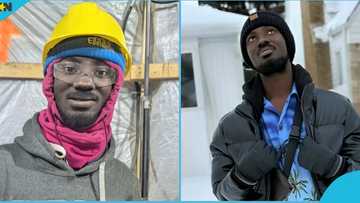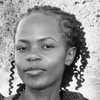Mole-Dagbon tribe: History, food, dance, languages, weapons, facts
The Mole Dagbon tribe is one of the largest ethnic groups in Ghana. This ethnolinguistic group is also present in other parts of West Africa: Burkina Faso, Benin, Mali, Ivory Coast, and Togo. Learn about this fascinating tribe, which all trace their roots to a single ancestor.

Source: Twitter
TABLE OF CONTENTS
- Mole-Dagbon tribe
- What is the Mole-Dagbani dressing code?
- Who led the Mole-Dagbani to Ghana?
- Who are the Dagbon people?
- Who are the descendants of Tohazie?
- Mole-Dagbon tribe fast facts
Ghana is a West African country with rich traditions and cultures. Most tribes in the country view time as a sequence of events instead of minutes and hours. The country comprises several ethnic groups, and each group has its traditions. The mole-Dagbonribe is one of the ethnic groups whose culture is prosperous and vibrant.
Mole-Dagbon tribe
The Mole-Dagbani tribe comprises around 17 per cent of Ghana's current population. The tribe also accounts for the majority of the country's Muslim population. It has five sub-cultures: Mossi, Nanumba, Mamprusi, Dagomba, and Gonja.
The Mole-Dagbani history
The Mole-Dagbani ethnic group is descended from one ancestor, Naa Gbewaa. Mole-Dagbani are all grandchildren of Naa Gbewaa, the son of Kpognambo. Kpognambo's father was Tohadzie, also known as “The Red Hunter.”

Read also
Late Anloga chopbar operator's family to consult Nogokpo to unmask culprits, more details drop
The Red Hunter was the son of Tiyawumya, who lived around the 11th to the 12th century. Tiyawumwa descended from King Shabaka, one of the Black Pharaos who ruled the Royal Family of ancient Egypt.
The origin of the Mole-Dagbani group
The Mole-Dagbon tribe in Ghana is descended from Naa Gbewaa's four children: Sitobu, Tohagu, Gmantambo, and Yennenga. When Naa Gbewaa died, his sons from different mothers fought for the chieftaincy. Sitobu, Tohagu, and Gmantambo moved southward and established permanent residences in different areas near each other.
Tohagu settled permanently in Gambaga and established the Mamprusi people with his followers in the northeast region of Ghana. Sitobu settled in Nambrugu in the Kariga district and founded the Dagbon Kingdom.
The kingship was known as Yaa-Naa, which means king of strength. Sitobu became one of the most successful siblings. He was celebrated as "Sigri ni tobu, duri ni nam," which means "Descending with war and ascending as King."
Gmantambo, on the other hand, founded the Nanung, a people who came to be known as the Nanumbas. The Nanumbas chose Bimbila in the Northern Region as their capital.

Read also
5 things you never knew about Alfred Okyere, the Ghanaian student killed by a colleague in Canada
Yennenga, the courageous warrior daughter of Naa Gbewaah, married Grumah. Together, they established the Kingdom of Mossi, which gave rise to the Ouedraogo ethnic group. The Mossi and Dagombas forged a strong bond.
The four children of Naa Gbewaa led to the formation of the Mole-Dagbon tribe in Ghana. The larger ethnic group live in Benin, Burkina Faso, Ivory Coast, Mali and Togo.
Currently, a shrine dedicated to Naa Gbewaa is located in Pusiga, 90 km east of Bolgatanga, a municipal area in the Upper East Region of Ghana.

Source: Twitter
Where did the Mole-Dagbani migrate from?
The Mole Dagbani migrated from northeast of Lake Chad to the south of the Niger bend, Zamfara, modern-day Nigeria. The tribe is believed to have originated from these regions around the 13th century.
Who led Mole-Dagbani to Ghana?
Toha-zie, the red hunter, is the ancestor who led the final southwestern migration. The tribe had some military and political superiority. Therefore, the ancestors could easily move smaller tribes into their kingdom.
What is the culture of the Dagbon?
The Mole-Dagbani have distinctive traditional and cultural practices that set them apart from other tribes. They are very withdrawn because of their Islamic beliefs. Their culture is also highly dependent on oral tradition. Here are the aspects that make up their culture and traditions.
Traditional kingdom and administration
Yaa-Naa is the king of the Dagbon traditional kingdom. The court and administrative capital of this kingdom is at Yedi. The seat of the king of Dagbon, known as the King of Absolute Power, is a collection of cow and lion skin.
Therefore, the political system is commonly known as Yendi skin. The houses are arranged precisely in the kingdom, with the chief's or elderly man's hut built in the middle.
Another major feature in the administration of the Mole-Dagbon tribe is chieftaincy. This system is very hierarchical, with the paramount chief being the head. A tiered system of governance rules under him. The tiered structure is made of:
- The paramount chief
- Council of elders
- Tendana - Owner of the land
- Sub-chiefs
- Village herdsman
Mole-Dagbani food

Source: UGC
Many people in the tribe are farmers. Men work on the farms while women help during the harvesting period. Their main crops are millet, sorghum, yams, maize, and peanuts.
The tribe also keeps sheep, cattle, guinea fowl, chickens, and goats, while others participate in fishing and hunting. Their food is made of the things they rear or plant.
Language of Mole-Dagbani
Mole-Dagbon speaks the Gur language of Ghana, also known as Dagbani, Dagbanle, or Dagbanli. It is widely spoken in northern Ghana, especially among the leadership of the king of Dagbon. Mole-Dagbani languages are compulsory subjects in primary and junior schools in Dagbon kingdom.
Dance and music
Mole-Dagbani dance and music are some of the core of its people. Through the art of dancing and music, they preserve their history for generations. They consider dancing as a form of expressing their emotions. The Dagbani people also use it for social interactions and physical exercise.
Through dance, people can illustrate and articulate a story or idea. The Dagbamba people have also embraced and incorporated a modern form of music and dance into their traditional one. At the local level, Dagbani music is heard in non-traditional music genres such as hip hop, reggae, Islamic music, or hip life.

Read also
MP for Ketu South Abla Dzifa Gomashie nominated as Minister for Tourism, Culture and Creative Arts
Mole-Dagbani festivals

Source: UGC
Bugum (fire festival) and Damba are two of the most important festivals. The Damba festival, which is celebrated by both the chiefs and the people, takes place during the third month of the Islamic calendar.
It is celebrated to mark the Holy Prophet Muhammud's birth and naming. The festival is divided into three different sections:
- The Somo Damba
- Naa Dama
- Belkusi
Clan and lineage
The Dagbon people live in compact, walled villages. Every household comprises related men, wives, children, and other dependents. The tribe's population is divided into two groups: chiefly families and commoners.
The patrilineage is the basis of social organization among the people. Matrilineal descent is acknowledged and accredited with the contribution of the spiritual attributes of an individual. The patrilineages are partitioned into different hierarchically arranged sections, which are made of:
- Lineage heads
- Custodians of ancestral shrines
- Moral authority leaders
A kinship unit is a descent group referred to as the dang. It is made of descendants of a single great-grandfather or grandfather. Only the sons of Ya-Na are eligible to rise to office.
Mole-Dagbani weapons
The Mole-Dagbon people heat and mould iron and steel to make everything from household items to weapons. Some of the weapons used by this tribe include:
- Daggers
- Knives
- Spears
- Axes
- Currency blades
- Cowhide shields
- Bows and arrows
What is the Mole-Dagbani dressing code?
The smock is the most distinctive dress among them. It is shaped like the London drum of the Dagombas; two ends are broader, and the middle is trimmer. When stitched together, the smock makes a beautiful dress.

Source: Facebook
Who led the Mole-Dagbani to Ghana?
The four children of Naa Gdewaa, Sitobu, Tohagu, Gmantambo, and Yennenga, led their followers to Ghana and neighboring countries in West Africa. The four are the founders of the Mole-Dagbon tribe.
They moved southward from North Africa following the war over the chieftaincy after their father, Naa Gdewaa, died.
Who are the Dagbon people?
The Dagomba ethnic group inhabits the Dagbon region in northern Ghana. They are a subgroup of the Mole-Dagbon tribe.
Who are the descendants of Tohazie?
The Yaanabihi are known as the descendants of Tahozie, The Red Hunter. The Mole-Dagbani are descended from Tohazie.
Mole-Dagbon tribe fast facts
- Which ethnic groups are the Mole-Dagbani is made up of? The five main ethnic groups include Mamprusi, Mossi, Dagomba, Nanumba and the Gonja.
- Who is the founder of Mole-Dagbani? The four children of Tohazie, Sitobu, Tohagu, Gmantambo and Yennenga, founded the Mole-Dagbon tribe.
- Where did the Mole-Dagbon tribe come from? They are believed to have originally migrated from the regions around Lake Chad.
- When did the Mole-Dagbani arrive in Ghana? They arrived between the 12th and 15th centuries.
- Why did the Mole-Dagbani migrate to Ghana? They migrated to Ghana in search of new hunting grounds.
- The Mole-Dagbani are found in which region of Africa? Mole-Dagbani regions include the Northern Region of Ghana in the sparse savanna region below the Sahelian belt. They are found in Benin, Burkina Faso, Ghana, Ivory Coast, Mali, and Togo.
- What is the Mole-Dagbani ethnic group language? Mole Dagbon speaks the Gur language of Ghana. The language is also known as Dagbani, Dagbanle, or Dagbanli.
The Mole-Dagbon tribe is one of the earliest inhabitants of Ghana. Its fascinating culture and historical background characterize it. The tribe passes its culture orally from generation to generation. The group can trace its origins to King Shabaka, one of the Black Pharaohs of ancient royal Egypt.
Yen.com.gh shared an interesting piece about the Ga-Adangbe tribe, its language, traditional wear, dances, food, and religion. Ghana is among the West African countries with rich traditions and cultures. Several ethnic groups in Ghana have unique traditions, and the Ga-Adangbe tribe is one of the ethnic groups with a vibrant culture.
The Ga-Adangbe or Ga Adangme people are usually grouped as part of the Ga-Dangme ethnolinguistic groups of Ghana, Benin, and Togo. They mainly live in the Greater Accra region, and Dangme is the language most used in the Greater Accra Plains.
Source: YEN.com.gh

Julian Mireri (Lifestyle writer) Julian is a content creator who has been working with Yen since 2018. She graduated from the University of Nairobi with a Bachelor’s Degree in Project Planning and Management in the year 2013. Think of her as a content whisperer and a gifted storyteller who never disappoints when it comes to finding the right words for her pieces. Email: julianmireri@gmail.com

Sharon Boit (Lifestyle writer) Sharon J. Boit is a creative writer and researcher with over 10 years of experience. She began her career as a project manager and researcher at the Center for Urban Research and Innovations, University of Nairobi. Sharon has written articles and blog posts for MSN News, Ihamba Adventures, and Industry Biz. She joined Yen.com.gh as a Lifestyle Writer in October 2024, covering entertainment, sports, education, and finance. You can reach Sharon J. Boit by email at boit@gmail.com.





